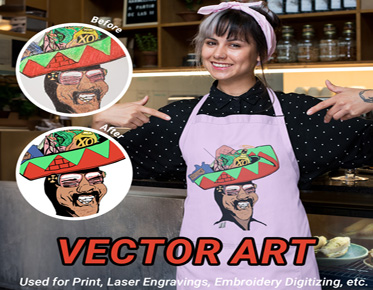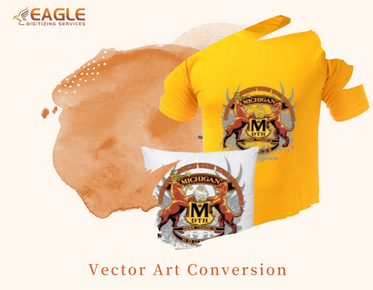Dive into Jacket Back Embroidery Digitizing: What’s It All About?
Custom jacket back embroidery offers a unique and stylish way to personalize outerwear, turning a simple jacket into a statement piece. The allure lies in the ability to showcase creativity and individuality through detailed, vibrant designs that stand out. Whether it's a bold logo, intricate artwork, or meaningful text, embroidery adds a touch of sophistication and exclusivity to any jacket. If this post has captured your attention regarding embroidery digitizing and you want to learn additional information, feel free to reach us.
Why Embroidery is a Popular Choice for Jacket Personalization
Embroidery has become a favored choice for jacket personalization due to its durability and timeless appeal. Unlike other methods, such as screen printing, embroidery embeds the design into the fabric, ensuring it lasts through countless washes and wears. Its tactile quality and intricate stitching elevate the overall look, making it a popular option for both casual and formal attire.
The Importance of Jacket Back Embroidery
Why the Back of a Jacket is a Prime Spot for Embroidery
The back of a jacket provides a prominent and expansive canvas, making it an ideal location for embroidery. This area offers ample space for large, eye-catching designs and ensures that the embroidery is visible from a distance. It's a prime spot for showcasing logos, team emblems, or elaborate artwork, enhancing both the visual appeal and impact of the jacket.
Popular Uses for Jacket Back Embroidery: From Sports Teams to Corporate Branding
Jacket back embroidery finds widespread use across various domains. Sports teams often use it to display team logos and player numbers, creating a sense of unity and identity. Corporate entities leverage jacket back embroidery for branding purposes, using it to promote company logos and enhance employee uniforms. Custom designs can also cater to personal or promotional needs, making it a versatile choice for diverse applications.
The Visual Impact of Embroidered Designs on Jacket Backs
Embroidered designs on jacket backs create a striking visual impact, combining vibrant colors and intricate details that stand out. The texture of embroidery adds depth and dimension, making the design not only visible but also tactile. This visual appeal contributes to a jacket’s overall aesthetic, making it a memorable and stylish piece of clothing.
The Digitizing Process for Jacket Back Embroidery
Step-by-Step Overview of the Digitizing Workflow
The digitizing workflow involves several key steps:
1. Artwork Review: Analyzing the provided design and assessing its suitability for embroidery.
2. Design Conversion: Translating the artwork into digital stitches using specialized software.
3. Thread Selection: Choosing appropriate thread types and colors based on the design.
4. Stitch Planning: Mapping out stitch types and patterns to achieve the desired effect.
5. Machine Simulation: Running a virtual simulation to check for errors and adjust as needed.
6. Finalizing Files: Generating the stitch file in a format compatible with the embroidery machine.
From Artwork to Embroidery File: The Conversion Process
Converting artwork into an embroidery file involves several stages. The initial step is vectorizing the artwork, followed by assigning stitch types and directions. The design is then adjusted for size and density, ensuring it translates well onto fabric. The final stitch file is tested virtually to confirm accuracy before being used in the actual embroidery process.
Key Software Tools Used in Digitizing Embroidery Designs
Several software tools are integral to the digitizing process. Popular options include Wilcom, Hatch, and Brother PE-Design, which offer comprehensive features for designing, editing, and converting artwork into embroidery files. These tools enable digitizers to manipulate designs, optimize stitch settings, and ensure the final output meets high standards of quality.
Design Considerations for Jacket Back Embroidery
Choosing the Right Design Elements for Jacket Backs
When selecting design elements for jacket backs, consider factors such as visibility, size, and relevance. Opt for bold, clear graphics that stand out against the jacket's fabric. Incorporate elements that reflect the purpose of the jacket, whether it’s for a team, company, or personal use, ensuring that the design aligns with the intended message.
How to Adapt Designs for the Size and Shape of a Jacket Back
Adapting designs for the size and shape of a jacket back requires scaling and positioning adjustments. Ensure the design fits well within the available space, avoiding overly intricate details that might get lost or appear crowded. Consider the jacket’s cut and seams, making adjustments to ensure the design complements the garment’s structure and enhances its appearance.
Balancing Detail and Simplicity in Jacket Back Designs
Balancing detail and simplicity is crucial for effective jacket back designs. While intricate details can add visual interest, they must be balanced with simplicity to ensure clarity and legibility. Aim for a design that is visually striking yet straightforward enough to be easily recognized and appreciated.
Preparing Artwork for Digitizing
How to Prepare and Submit Your Artwork for Embroidery Digitizing
Preparing artwork for embroidery digitizing involves ensuring that the design is in a high-resolution format and suitable for conversion. Submit artwork in vector formats like AI or EPS for best results, and provide clear instructions regarding colors and thread choices. High-quality, well-defined artwork facilitates a smoother digitizing process and results in a more accurate final product.
The Role of Image Quality and Format in Successful Digitizing
Image quality and format play a significant role in successful digitizing. High-resolution images with clear outlines and minimal pixelation translate better into embroidery files. Vector formats are preferred because they provide scalable, clean lines that maintain their integrity throughout the digitizing process.
Tips for Ensuring Your Design Transfers Well to Embroidery
To ensure your design transfers well to embroidery, simplify complex elements and avoid fine details that might not render well. Use contrasting colors to enhance visibility and make sure your design is appropriately sized for the jacket back. Providing clear instructions and working closely with your digitizer can also help achieve the best results.
Customizing Your Jacket Back Design
How to Add Personal Touches to Your Embroidered Design
Adding personal touches to your embroidered design can make your jacket truly unique. Incorporate names, personalized logos, or custom text to reflect individual or team identity. Personalization adds sentimental value and makes the jacket a more special and memorable item.
Incorporating Text, Logos, and Images in Jacket Back Embroidery
Incorporate text, logos, and images thoughtfully to create a cohesive design. Ensure that text is legible and logos are accurately represented, and consider how these elements will interact with the overall design. Balancing different components helps create a unified and visually appealing embroidered jacket.
Choosing Colors and Threads for Maximum Impact
Selecting the right colors and threads is crucial for making your embroidered design stand out. Choose colors that contrast well with the jacket’s fabric to enhance visibility. Opt for high-quality threads that provide durability and vibrant colors, ensuring that your design looks sharp and professional.
Machine Embroidery vs. Hand Embroidery
Comparing Machine Embroidery to Hand-Stitched Designs
Machine embroidery offers efficiency and consistency, making it ideal for large-scale projects or intricate designs. It provides precise stitching and faster production times compared to hand embroidery. Hand-stitched designs, on the other hand, offer a unique, artisanal quality with individualized attention to detail.
The Benefits of Machine Embroidery for Jacket Backs
Machine embroidery provides several benefits for jacket backs, including speed, precision, and the ability to handle complex designs with ease. It is well-suited for producing high-quality, durable designs in larger quantities, making it a practical choice for personalized jackets.
When to Choose Hand Embroidery Over Machine Techniques
Hand embroidery may be preferred for its artisanal touch and the ability to create unique, one-of-a-kind designs. It is ideal for projects where personal craftsmanship is valued or for intricate details that require manual skill. Choose hand embroidery when you want a distinctive, handcrafted quality that machine techniques cannot replicate.
Quality Control in Jacket Back Embroidery
Ensuring High-Quality Embroidery through Proper Digitizing
High-quality embroidery starts with proper digitizing. Ensuring that the design is accurately converted into a stitch file and that all settings are optimized helps achieve a professional finish. Quality control measures during the digitizing process contribute to a successful final product.
How to Spot and Fix Common Embroidery Issues
Common embroidery issues include thread breaks, misalignment, and stitching errors. Spot these issues by inspecting samples and running test stitches. Address problems by adjusting machine settings, thread tension, and digitizing parameters to correct and prevent issues.
The Role of Professional Digitizers in Maintaining Quality
Professional digitizers play a crucial role in maintaining quality by applying their expertise to ensure accurate and aesthetically pleasing designs. Their experience in handling various design complexities and machine settings helps achieve high standards of embroidery, resulting in a superior final product.
Cost Factors in Jacket Back Embroidery
What Influences the Cost of Jacket Back Embroidery Projects
The cost of jacket back embroidery projects is influenced by factors such as design complexity, size, and the number of colors used. Additional elements, such as special thread types or intricate stitching techniques, can also impact pricing. Understanding these factors helps in budgeting and planning for your embroidery project.
How Complexity and Size Affect Pricing
Complex designs with multiple colors and intricate details generally cost more due to the increased time and resources required for digitizing and stitching. Larger designs that cover a significant portion of the jacket back also contribute to higher costs. Balancing design complexity and size with your budget is key to managing expenses.
Tips for Budgeting Your Embroidery Project
Budgeting for an embroidery project involves evaluating design elements, size, and production quantities. Obtain quotes from different digitizers and consider any additional costs for revisions or special requests. Planning and setting a realistic budget helps ensure a successful project within your financial limits.
Caring for Embroidered Jackets
How to Maintain and Care for Your Embroidered Jacket
Maintaining and caring for your embroidered jacket involves following proper cleaning and storage guidelines. Wash the jacket according to fabric care instructions, preferably in cold water and gentle detergent. Avoid harsh chemicals and direct heat to preserve the embroidery.
Tips for Cleaning and Storing Embroidered Jackets
When cleaning embroidered jackets, turn them inside out to protect the embroidery and use a mild detergent. For storage, keep the jacket in a cool, dry place away from direct sunlight. Proper care helps maintain the jacket’s appearance and ensures the longevity of the embroidery.
How to Preserve the Longevity of Your Embroidery
To preserve the longevity of your embroidery, handle the jacket gently and avoid excessive friction. Store the jacket in a breathable garment bag to prevent dust and damage. Regularly inspect the embroidery for signs of wear and promptly address any issues to maintain its quality.
Jacket back embroidery remains a timeless choice due to its ability to blend artistry with functionality. Its durability, customization options, and classic appeal make it a popular and enduring method for personalizing jackets. Embroidery adds a touch of elegance and individuality that stands the test of time.



